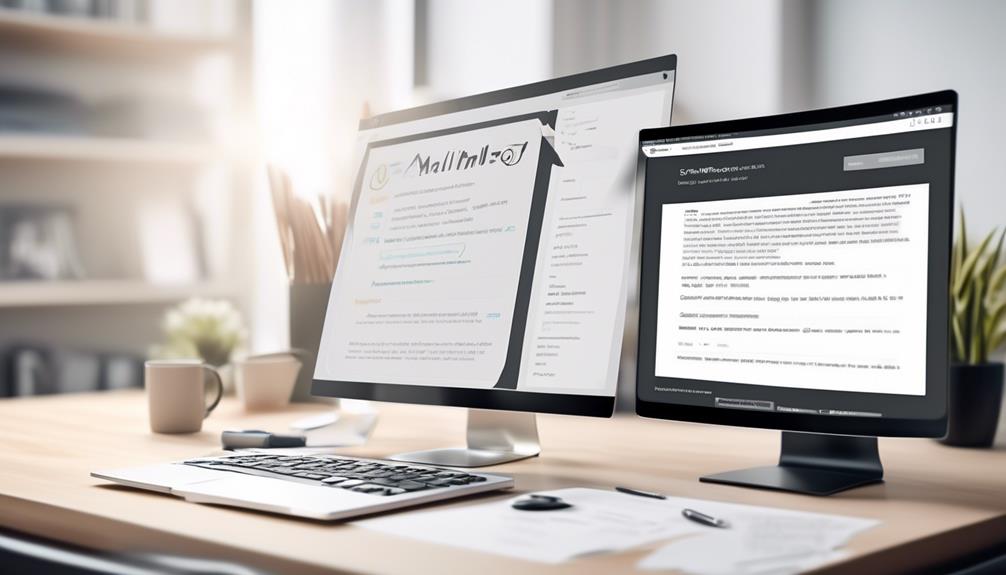We’ve all experienced it – making an error in an email can seem like a catastrophe, but don’t worry, there exists a smooth method to amend it without adding to the confusion.
We've all received that sinking feeling when we realize we've sent out an email with an error, and the panic that follows. But before you hit the panic button, there are some effective strategies to navigate this situation with professionalism and poise.
So, how do you ensure your mistake correction email is both effective and well-received? Let's explore the art of crafting an email that rectifies the error while maintaining a positive professional image.
Key Takeaways
- Craft a clear and straightforward subject line for the email correction, indicating that it is a correction email and including relevant information.
- When self-correcting, acknowledge the mistake, apologize sincerely, explain the error, provide the correct information, and reassure the recipient of preventive measures.
- When diplomatically correcting others' mistakes, acknowledge the mistake, apologize for any confusion or inconvenience, provide the correct information, maintain a respectful tone, and preserve professional relationships.
- When sending an email correction, acknowledge the mistake, apologize sincerely, take responsibility for the error, explain how it occurred, provide the correct information or rectify the mistake, and express gratitude while reassuring the recipient.
Crafting the Perfect Subject Line
Crafting the perfect subject line for an email correction is essential for ensuring clarity and prompt attention. When we make a mistake in an email and need to send a correction, the subject line plays a crucial role in communicating the purpose of the email. It should clearly indicate that it's a correction email, making it easier for the recipient to identify and prioritize it. Including relevant information in the subject line, such as 'Error: my previous email contained a mistake,' or 'Correction: I sent the last email in error,' helps in providing a quick overview of the email's content.
To ensure professionalism, the subject line should be clear and straightforward, leaving no room for ambiguity. It should also be crafted in a way that increases the chances of the email being read promptly. An effective subject line demonstrates accountability and transparency, which are essential in acknowledging the mistake and conveying a sense of urgency in the correction process.
Examples of Self-Correction Emails

After ensuring a clear and compelling subject line for your correction email, the next step is exemplifying effective self-correction through the content of the email itself. When crafting your self-correction email, it's crucial to acknowledge the mistake and apologize sincerely.
For example, 'I apologize for the confusion caused by the incorrect information in my previous email.'
Next, explain the error and provide the correct information to rectify the mistake. Ensure a professional and courteous tone throughout the email, such as 'Upon reviewing the details, I realized that there was a mistake in the previous communication. The accurate information is as follows.'
Additionally, reassure the recipient of the steps being taken to prevent future mistakes. An example could be, 'To prevent similar errors in the future, I've implemented additional review processes.'
Finally, thank the recipient for their understanding and patience. For instance, 'Thank you for your understanding, and I appreciate your patience as we work to resolve this matter.'
Diplomatically Correcting Others' Mistakes
When correcting others' mistakes, it is essential to approach the situation with respect and provide constructive support to preserve professional relationships. Diplomatically correcting others' mistakes involves acknowledging the error, apologizing for any confusion or inconvenience, and providing the correct information in a professional and courteous manner. It is crucial to make things right while maintaining a respectful tone in all professional communication.
| Diplomatic Correction Strategies | Example |
|---|---|
| Acknowledge the mistake | "I noticed an error in the report." |
| Apologize for any confusion | "I apologize for any inconvenience the error may have caused." |
| Provide the correct information | "The accurate figure should be 250 units." |
When sending a correction email, it is important to clearly indicate in the subject line that it is a correction and include relevant details. The email should be clear, concise, and emphasize the need for a solution if the correction is urgent. By diplomatically correcting an incorrect piece of information, it demonstrates professionalism and a commitment to accuracy in communication.
Tips for Sending an Email Correction

Moving from the discussion of diplomatically correcting others' mistakes into tips for sending an email correction involves understanding the importance of maintaining professionalism and accuracy in all forms of communication. When sending the correction, it's crucial to acknowledge the mistake and apologize sincerely. Take responsibility for the error and explain how it occurred, as this shows accountability and transparency. Provide the correct information or rectify the mistake in a clear and concise manner. Reassure the recipient that measures are in place to prevent future mistakes, demonstrating that you're actively working to improve. Express gratitude for the recipient's understanding and patience, as this helps to maintain a positive relationship.
When crafting the subject line, be specific and concise to convey the purpose of the email. Additionally, ensure that the body of the email is well-structured, using a professional tone and language. It's important to correct your mistakes in a timely manner to mitigate any potential impact. By following these tips, you can effectively send an email correction while upholding professionalism and accuracy in your communication.
Best Practices for Apology Emails
Our approach to composing apology emails centers on acknowledging errors and expressing genuine regret, while also providing clear and feasible solutions to rectify mistakes and prevent future occurrences.
When crafting an apology email, it's essential to evoke emotion in the audience by:
- Using a sincere and empathetic tone to convey genuine regret and understanding of the inconvenience caused.
- Personalizing the apology by addressing the recipient directly and acknowledging the specific mistake made.
- Expressing gratitude for the recipient's understanding and patience, highlighting the value placed on the professional relationship.
- Offering a clear and feasible solution to rectify the mistake, demonstrating a proactive approach to resolving the issue.
- Communicating a plan to prevent similar errors in the future, showcasing a commitment to improvement and preventing recurrence.
Frequently Asked Questions
How Do You Write a Letter to Correct a Mistake?
We write a letter to correct a mistake by acknowledging the error, expressing regret, and providing a clear solution.
We take responsibility for the mistake and outline the steps to rectify it.
It's important to be polite and professional, offering support if needed.
A compelling subject line indicating a correction email is key, along with relevant information.
This approach ensures a respectful and effective way to address and rectify mistakes in written communication.
How Do You Correct Someone Professionally in an Email?
We correct someone professionally in an email by acknowledging the mistake, taking responsibility, and offering a solution.
We maintain a polite and professional tone, providing clear and concise information on the correction.
It's important to express gratitude for the recipient's understanding and patience.
This approach demonstrates accountability and respect, fostering a positive and constructive communication environment.
How Do You Send a Corrected Email?
When sending a corrected email, we ensure to acknowledge the mistake sincerely, take responsibility, and offer a clear explanation.
We express gratitude for the recipient's understanding, offer a solution, and assure steps are being taken to prevent future mistakes.
It's crucial to maintain a professional tone and clarity throughout the email, ensuring the recipient feels respected and valued.
This approach fosters a positive and constructive communication flow.
How Do You Write a Typing Mistake in an Email?
We acknowledge a typing mistake in an email by promptly addressing it. We take responsibility and sincerely apologize for any inconvenience caused.
We clearly explain the correct information, reassuring the recipient that steps are being taken to prevent future errors. Our email maintains a professional and courteous tone throughout.
This approach helps rectify the mistake and ensures that our communication is accurate and reliable.
Conclusion
In conclusion, correcting mistakes via email is like untangling a knot – it takes patience, precision, and a gentle touch.
By acknowledging the error, offering a solution, and maintaining a professional tone, we can smooth out any misunderstandings and strengthen our professional relationships.
Remember, mistakes happen, but it's how we handle them that truly matters.










